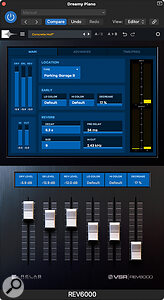I recall being hugely impressed by the original TC System 6000 reverb (which we reviewed way back in SOS April 2003). That ran on the extremely costly System 6000 hardware platform, which used algorithms rather than IRs, but the original System 6000 reverb incorporated a technology called ‘ray tracing’ to create extremely accurate‑sounding early reflections alongside traditional FIR (Finite Impulse Response) filters. In a real space, the early reflection pattern varies depending on the location of the source within the space, and ray tracing proved an effective approach for recreating this element of the reverb character.
In terms of the processing, essentially it means that the plug‑in feeds multi‑tapped delays into EQ and diffusion blocks to create synthetic early reflections. A benefit of this particular algorithmic approach is that you get a wonderfully IR‑like realism, but with full parameter adjustment, so the original System 6000 reverb worked really well for recreating believable ‘real’ spaces — in this respect, I’d say there are some parallels with what Bricasti achieved some years later.
TC themselves offer their algorithms in plug‑in form today, but several other companies have emulated the TC original, and the latest to do so are Relab, with their new VSR REV6000 plug‑in. They’ve produced an emulation designed to capture the specific character of the original hardware, which itself was used in numerous film soundtracks and music scores, and it’s essentially a stereo distillation of the surround algorithms that ran on the System 6000. This plug‑in supports all the mainstream Mac/Windows formats, including AAX, and authorisation is via an iLok account.
The effects available range from small room ambiences and studio rooms to large halls and cathedrals, all of which add a real sense of dimension to the sound being treated. The documentation informs us that while typical reverb plug‑ins allow control over individual parameters, each affecting only one aspect of the sound, the VSR REV6000 takes more of a ‘macro’ approach — a single adjustment might change numerous parameters behind the scenes. This makes the VSR REV6000 easy to navigate while still producing top‑tier results. As expected there are numerous factory presets, and they make excellent starting points for your own adjustments, as the sense of space and location that they conjure up is seriously impressive.
You get a wonderfully IR‑like realism, but with full parameter adjustment.
The GUI is arranged as three tabbed views, the first being Main, which hosts the preset name, tonal colour control over the early reflections and the main reverb parameters: Decay, Size, Pre‑delay and Hi‑cut. Metering to the right shows the input and output levels, and there’s additional metering to the left for each of the Dry, ER and Rev levels. Large faders at the bottom of the screen adjust the Dry Level, Early Reflections Level, Reverb Level, Lo Colour, Hi Colour and Decrease, the last of which controls the amount of higher‑order reflections.
 In Advanced and Time/Freq views, the upper section changes to show different reverb parameters.
In Advanced and Time/Freq views, the upper section changes to show different reverb parameters.
 Advanced view keeps the faders at the bottom of the screen but replaces the top half with access to early reflections start and stop time adjustment, reverb type and size, modulation and output format selection, with independent delay time adjustment for the output channels.
Advanced view keeps the faders at the bottom of the screen but replaces the top half with access to early reflections start and stop time adjustment, reverb type and size, modulation and output format selection, with independent delay time adjustment for the output channels.
The third tab, which again retains the faders, allows you to adjust the EQ and damping values, as well as the reverb time (in four frequency bands with user‑adjustable crossover points). There are options to process left and right channels differently, and each emulated location incorporates different filtering and reverb settings — a club room, for example, sounds very different from a concert hall, even if you dial in the same settings.
Summary
To summarise, Relab’s VSR REV6000 excels at emulating real spaces, from the very small to the very large — the sounds it offers really are excellent. Of course, sometimes you might want a less ‘real’, more characterful‑sounding reverb for your music project, so it’s worth me mentioning that Relab offer a range of emulations of other algorithmic reverbs too, and all those I’ve tried have sounded great. But if you need to be able to dial in a real‑sounding space, and would like more flexibility and control than is possible with impulse responses alone, then VSR REV6000 would be well worth a demo: it does a first‑rate job at a very sensible price.

